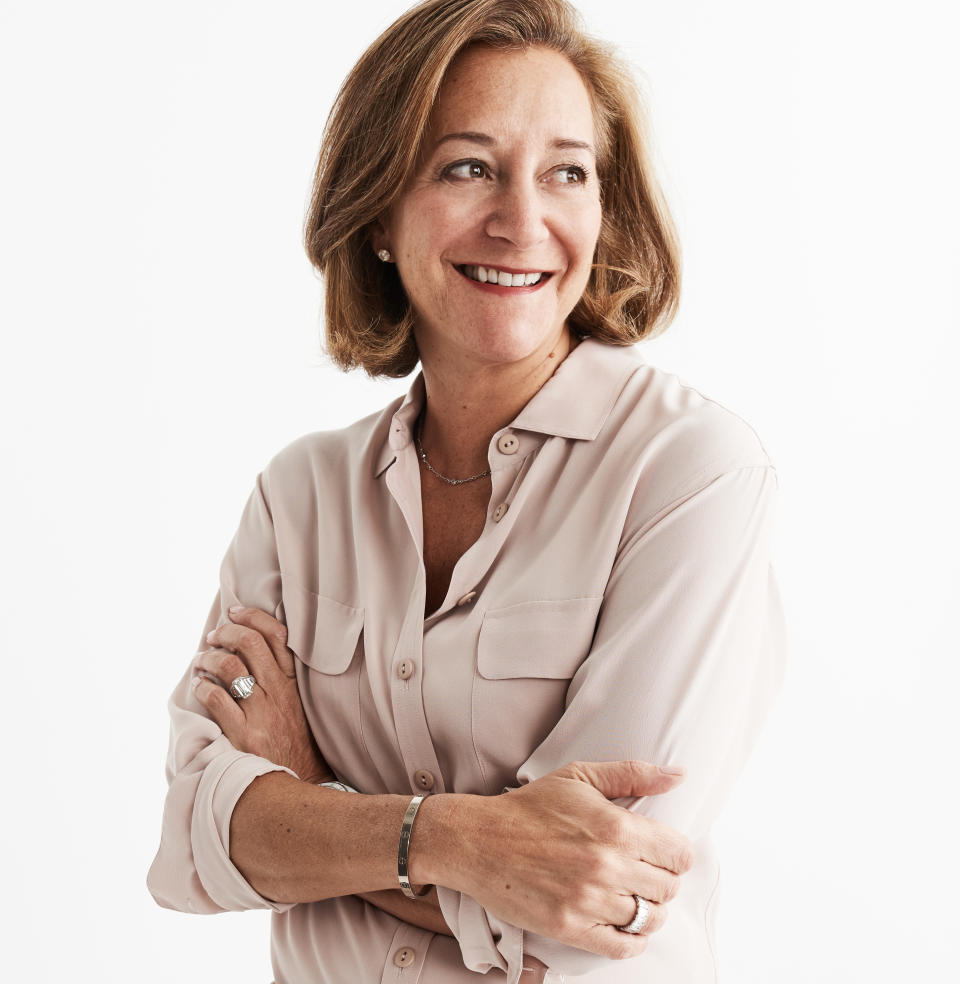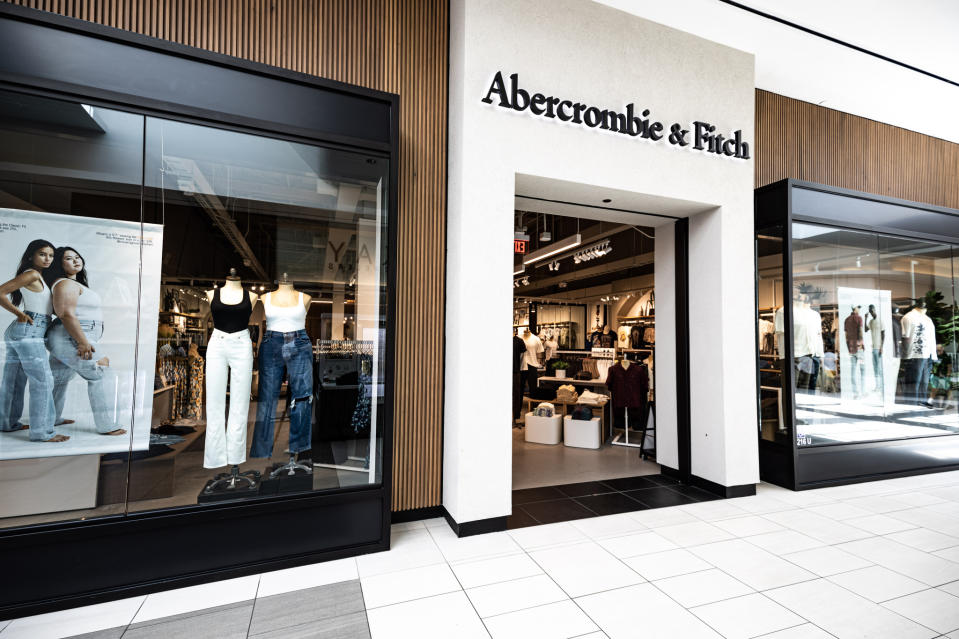Abercrombie & Fitch Posts Solid Quarter, Raises Outlook
- Oops!Something went wrong.Please try again later.

Story was updated Aug. 23 at 4:19 p.m.
Abercrombie & Fitch Co., demonstrating strength across brands and geographies during the second quarter, has Wall Street fired up.
More from WWD
After the company reported Wednesday that it moved into the black during the second quarter and raised its outlook for the year, A&F’s stock took off. By the closing bell Wednesday, the stock rose more than 23 percent, or $9.69, to $50.86.
The specialty retailer posted net income of $58.71 million, or $1.10 a diluted share, for the quarter ended July 29, compared to a net loss of $16.83 million, or $0.33 a diluted share, in the year-ago period.
Operating income came to $90 million, compared to an operating loss of $2 million. The operating margin of 9.6 percent was a significant expansion from about break even last year.
Sales rose 16 percent to $935.35 million from $805 million, with gains seen across all regions. Comparable sales rose 13 percent.
The results also seemed to transcend an industrywide perception that consumer demand for discretionary products is waning for several reasons, among them that Americans are depleting their savings, pinched by inflation and rising interest rates, and worried the end of student loan forgiveness is approaching. Many retailers see consumers spending less on stuff and leaning toward travel, restaurants and other experiences, but there’s a somewhat different perspective emanating from A&F.
“Our take on any economic cycle is that you see winners and losers out there and we are winners. Our playbook is working,” Fran Horowitz, chief executive officer of Abercrombie & Fitch Co., told WWD on Wednesday.
“If he and she is going out for some experience, they need to look good going out. The consumer is definitely out there shopping. They are more judicious, but they are choosing to shop with us.”
Discussing what’s behind the ongoing success of the company, Horowitz told WWD, “We’ve really rebuilt this company. We’ve touched every function and have thought very differently how we run this business.”

With the Abercrombie brand, after years of rebuilding, there’s been 10 consecutive quarters of growth, Horowitz noted, adding, “We are no longer a jeans and T-shirt brand. We are truly a lifestyle brand. The Abercrombie customer is shopping for way more than causal wear.”
Over the last several seasons, Abercrombie has widened its target audience to 20- to 40-year-olds, and expanded its assortment into workwear, and fashion for getaways and going out, including dresses and pants as well as activewear.
Horowitz also said the company has become more regionally focused, having seasons ago built up talent in the London and Shanghai offices. “We’re staying close to our customer, and providing the right voice regionally.”
She said Hollister is at “a nice inflection point” and back to generating positive results. While Abercrombie has been thoroughly rebuilt, Hollister is continuing to evolve. At Hollister, “We’ve got to focus on the customer, maintain a strong product voice and experience, not lean on any one category, and move quickly,” because trends and the demand can rapidly change.
“Testing and reacting is very important. The chase is very important.”
With the supply chain stabilizing this year, “it means we can chase” products in demand. “The fact is that we could not chase last year due to the supply chain” being bottled up. “We had to pull our inventory forward and because of that we were not able to react as quickly as we would have liked to. [But this year,] with inventory down 30 percent, we are lean and agile. The teams will chase.”
Asked for her outlook on the 2023 holiday season, Horowitz replied, “We certainly have momentum going in the back half. We are pleased with August.”

Bestsellers during the second quarter continue to be bestsellers in August, Horowitz said, citing bottoms across gender and brands, men’s tops at Abercrombie and Hollister’s girls, which she said is selling better than Hollister guys.
In her prepared statement Wednesday, Horowitz said, “Our net sales and operating margin exceeded our expectations as global growth accelerated throughout the second quarter. We continue to see strong customer receptivity of our brands and product, led by 26 percent net sales growth in Abercrombie brands. To date, our efforts to evolve Hollister brands’ positioning and assortment are paying off, achieving a return to net sales growth at positive 8 percent for the quarter. Both brands saw gross profit rate improvement on higher average unit retail and lower freight costs. Operating leverage from sales growth and gross profit rate performance contributed to an operating margin of 9.6 percent, a significant expansion from second quarter of 2022.
“These strong results showcase the power of our playbook and our team’s ability to align product, voice and experience to meet our customers’ needs. Operationally, we are strategically managing inventory, leveraging chase capabilities to support demand and driving efficiency across our business.
“While the macro environment remains dynamic, our first half results give us confidence to stay on offense for the second half,” Horowitz added. “Consistent with our Always Forward Plan, we are continuing to open stores and make critical long-term investments in digital and technology that will keep our brands in position to exceed our customers’ expectations.”
Gross profit rate of 62.5 percent was up about 460 basis points compared to last year. The year-over-year improvement was primarily driven by a benefit of 400 basis points from year-over-year AUR growth and 340 basis points from lower freight costs, partially offset by 180 basis points from higher cotton and raw material costs and 60 basis points from the adverse impact from foreign currency.
Raising its outlook, the company now expects net sales growth of around 10 percent from $3.7 billion in 2022. This is an increase to the previous outlook of up 2 to 4 percent. “The current outlook assumes that Abercrombie brands will continue to outperform Hollister brands,” the company indicated. Also, fiscal 2023 includes a 53rd week for reporting purposes, along with net store expansion. The 53rd week is estimated to add about $45 million to total net sales in the fourth quarter and full year of 2023.
The operating margin is now projected to be in the range of 8 to 9 percent, compared to the previous outlook of 5 to 6 percent.
The challenge for A&F going forward is to maintain its momentum. It’s always difficult for a retailer to generate strong comps on top of strong comps, year after year.
“An 11 percent beat on sales is nothing to sneeze at for a mature retailer, even one with clear momentum behind it. But the 9.6 percent operating margin, 695 basis points ahead of expectations, is the predominant headline here, in our view, in the context of initial company plans for 8-plus percent operating margin by 2025 and 10 percent longer term,” wrote William Blair analyst Dylan Carden.
However, “This creates as much opportunity as risk, as one of the concerns we have had in the midst of A&F’s run is how sustainable sales and in turn the higher-than-expected operating margins are,” Carden added. “Clearly, the company is getting back to a level of more normalized gross margin, putting back freight costs that were artificially elevated last year. While that support wanes by the back half, they will not reverse out, and cotton prices should flip to more of a neutral-to-positive impact.
“We are more focused on what is happening within operating costs to gain a sense of how long the business can run at this level of margin, or if next year is setting up for some giveback, particularly on the store and distribution line as the company laps double-digit comp levels. For now, we see more limited room for upside, with some lingering support from the faster-than-expected Hollister recovery, which sets up the prospect of both brands running hot for some time that could only push margin further. At peak gross margin, and the lowest level of store and distribution expense ratio we have seen (in all but the retail recovery period of 2021), it is unclear how much higher margins can go as sales normalize into 2024.”
Best of WWD

